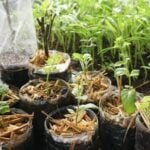Managing insect and mite pests in vegetable gardens E-194 is crucial for maintaining the health and productivity of your plants. These pests can wreak havoc on your vegetable garden, causing damage to crops and reducing yields. In this article, we will explore various techniques and methods for effectively managing insect and mite pests to ensure a successful harvest.
Insect and mite pests are common challenges that vegetable gardeners face, but with the right knowledge and strategies, they can be controlled. By understanding the common types of pests that may infest your garden, as well as how to identify signs of infestations, you can take proactive measures to address any issues before they become a major problem.
Integrated pest management (IPM) techniques play a key role in managing insect and mite pests in vegetable gardens. From natural and organic pest control methods to chemical control options, there are various approaches that can be used depending on the specific pest infestation.
Regular monitoring and inspections are also essential for early detection and intervention, while preventative measures can help minimize the risk of infestations occurring in the first place. Stay tuned as we delve into these topics in detail throughout this article.
Understanding the Common Insect and Mite Pests in Vegetable Gardens
Vegetable gardens are often targeted by a variety of insect and mite pests that can cause significant damage to crops if left unchecked. Some of the most common pests include aphids, caterpillars, whiteflies, thrips, spider mites, and beetles. Each of these pests can have a unique impact on specific types of vegetables, making it essential for gardeners to be able to identify them accurately.
Aphids, for example, are small insects that feed on the sap of plants, causing stunted growth and distorted leaves. Caterpillars also pose a significant threat as they consume foliage and can quickly defoliate entire plants if not controlled. Whiteflies and thrips are known for their ability to transmit viral diseases to plants, leading to reduced yields and poor-quality produce. Additionally, spider mites and beetles can cause severe damage by feeding on plant tissues or transmitting pathogens.
Gardeners must learn how to recognize the signs of infestation by these common pests in order to prevent widespread damage in their vegetable gardens. Identifying visual cues such as discolored leaves, wilting foliage, or the presence of eggs or larvae can help determine the type of pest present and guide effective management strategies.
By understanding the behavior and impact of each pest species, gardeners can make informed decisions regarding pest control methods while minimizing potential harm to beneficial insects and the environment.
| Common Pest | Potential Damage |
|---|---|
| Aphids | Stunted growth, distorted leaves |
| Caterpillars | Consumption of foliage leading to defoliation |
| Whiteflies & Thrips | Transmission of viral diseases resulting in reduced yields |
Identifying Signs of Insect and Mite Pest Infestations
Insect and mite pest infestations can wreak havoc on vegetable gardens, causing damage to crops and affecting overall yields. It’s important for gardeners to be able to identify the signs of insect and mite pest infestations in order to take appropriate action. Here are some common signs to look out for:
1. Wilting or yellowing leaves: If you notice that the leaves of your plants are wilting, turning yellow, or showing other signs of distress, it could be a sign of an insect or mite pest infestation. Certain pests like aphids and spider mites suck the sap from plant leaves, causing them to wilt and discolor.
2. Holes in leaves or fruit: Another obvious sign of insect pest infestation is the presence of holes in the leaves or fruit of your vegetable plants. This could indicate the presence of caterpillars, beetles, or other chewing insects that feed on plant tissue.
3. Sticky residue: Some insect pests secrete a sticky substance called honeydew as they feed on plants. If you notice a sticky residue on your plants’ leaves, it could be a sign of aphid or whitefly infestation.
Once you have identified signs of insect and mite pest infestations in your vegetable garden, it’s important to take action to manage these pests effectively.
By being proactive in identifying and managing insect and mite pests in your vegetable garden, you can help protect your crops and ensure a bountiful harvest.
Integrated Pest Management Techniques for Vegetable Gardens
When it comes to managing insect and mite pests in vegetable gardens, integrated pest management (IPM) techniques are crucial for effectively controlling and minimizing infestations. IPM involves using a combination of methods to prevent and manage pests in an environmentally responsible way. This approach focuses on long-term prevention of pests through a combination of biological, cultural, physical, and chemical controls.
One of the key components of IPM is promoting natural predators and beneficial organisms that help keep pest populations in check. This can involve introducing or encouraging the presence of insects or animals that feed on pests, such as ladybugs, lacewings, or birds. Additionally, utilizing crop rotation and companion planting techniques can disrupt pest lifecycles and reduce the likelihood of infestations.
Cultural controls also play a significant role in IPM for vegetable gardens. Practices such as proper sanitation, maintaining healthy soil fertility, and choosing pest-resistant plant varieties can all contribute to reducing the risk of pest problems. By creating a healthy and diverse garden ecosystem, the overall resilience of the plants can be improved, making them less susceptible to insect and mite pests.
| IPM Technique | Description |
|---|---|
| Natural Predators | Introduce beneficial insects or encourage wildlife that preys on garden pests |
| Cultural Controls | Implement practices such as crop rotation, companion planting, and maintaining soil health to minimize pest issues |
Natural and Organic Pest Control Methods
Introduction
In the quest for managing insect and mite pests in vegetable gardens e-194, many gardeners and farmers are turning to natural and organic pest control methods. These methods do not rely on synthetic chemicals, making them safer for both the environment and human health. In this section, we will explore a variety of natural and organic pest control options that can be implemented in vegetable gardens.
Cultural Control Methods
One of the first steps in natural pest control is implementing cultural practices that can help prevent or minimize pest infestations. This includes techniques such as crop rotation, intercropping, and companion planting. By rotating crops, planting different crops together, and utilizing companion plants that repel pests, gardeners can disrupt the life cycle of pests and create a less hospitable environment for them.
Biological Control Methods
Biological control involves using living organisms to manage pest populations. This can include introducing predatory insects or mites that feed on the pest species, releasing parasitic wasps that attack pest eggs or larvae, or even utilizing microorganisms like bacteria or fungi that are harmful to pests. By harnessing the power of natural predators and pathogens, gardeners can effectively reduce pest populations without resorting to chemical pesticides.
Overall, natural and organic pest control methods offer a sustainable approach to managing insect and mite pests in vegetable gardens e-194. By incorporating these methods into their gardening practices, individuals can promote healthy ecosystems while still protecting their valuable crops from destructive pests.
Chemical Control Options for Managing Insect and Mite Pests
When it comes to managing insect and mite pests in vegetable gardens, chemical control options can be an effective tool. However, it’s essential to use these methods carefully and responsibly to minimize harm to the environment, beneficial insects, and human health. Here are some chemical control options that can be considered for managing pest infestations in vegetable gardens:
1. Insecticides: Using insecticides can be an effective way to control insect pests in vegetable gardens. When choosing an insecticide, it is important to select one that targets the specific pest you are dealing with while being safe for use on edible crops. Some common insecticides used in vegetable gardens include pyrethroids, neonicotinoids, and spinosad.
2. Miticides: For mite pest infestations such as spider mites or broad mites, miticides can be used to effectively manage these pests. Just like with insecticides, it is crucial to select a miticide that targets the specific type of mite infesting your vegetable garden while being safe for use on edible plants.
3. Systemic Pesticides: Systemic pesticides are chemicals that are absorbed by the plant and distributed throughout its tissues. This means that when an insect or mite feeds on the plant, they will ingest the pesticide and be controlled. However, it’s important to note that systemic pesticides can also affect non-target organisms such as pollinators if not used properly.
When using chemical control options for managing insect and mite pests in vegetable gardens e-194, always read and follow label instructions carefully. It’s also important to consider alternative methods such as natural predators, cultural practices, and organic pest control before resorting to chemical treatments. When used responsibly, chemical controls can be a valuable tool in integrated pest management for vegetable gardens.
Importance of Monitoring and Regular Inspections
Regular monitoring and inspections are crucial for effectively managing insect and mite pests in vegetable gardens. By regularly checking the plants, gardeners can detect any signs of pest infestations early on, allowing for prompt and targeted action to prevent the pests from causing significant damage.
Monitoring can involve visually inspecting the plants for any visible signs of pests, such as chewed leaves, stunted growth, or discoloration. Additionally, setting up traps and using pheromones can help in monitoring the presence of specific pests.
Regular inspections also provide valuable information about the types of pests present in the vegetable garden, their population levels, and their behavior. This information is essential for determining the most appropriate pest management strategies to employ. For example, if a particular type of pest is found to be increasing in population, measures can be taken to address this specific issue before it becomes a widespread problem.
Furthermore, frequent monitoring and inspections contribute to an overall understanding of the health and condition of the vegetable garden. This allows gardeners to assess the effectiveness of their current pest management strategies and make any necessary adjustments.
It also helps in identifying any other factors that may be contributing to pest infestations, such as environmental conditions or cultural practices. Ultimately, by incorporating regular monitoring and inspections into their routine, gardeners can proactively manage insect and mite pests in their vegetable gardens while promoting plant health and productivity.
Preventative Measures for Minimizing Insect and Mite Pest Infestations
Proper Garden Planning and Layout
One of the most effective ways to minimize the risk of insect and mite pest infestations in vegetable gardens is by implementing proper garden planning and layout. This includes practicing crop rotation, intercropping, and utilizing companion planting techniques.
By rotating the placement of crops, you can disrupt the life cycles of pests and prevent them from building up large populations in a single area. Intercropping and companion planting involve growing different plants together to deter pests or attract beneficial insects that help control pest populations.
Implementing Physical Barriers
Another preventative measure for minimizing insect and mite pest infestations is by implementing physical barriers in the form of row covers, netting, or screens to protect crops from pests. These barriers act as a physical shield that prevents insects and mites from accessing plants, reducing the likelihood of infestations. Additionally, using floating row covers can also protect crops from certain pests while allowing sunlight, air, and water to reach the plants.
Promoting Biodiversity
Promoting biodiversity in your vegetable garden can also help reduce insect and mite pest infestations. Creating diverse habitats with a variety of plant species can attract natural predators such as birds, beneficial insects, and spiders that feed on pest insects.
This natural form of pest control can help keep pest populations in check without the need for chemical interventions. By creating a balanced ecosystem within your garden, you can create a more resilient environment that naturally manages insect and mite pests in vegetable gardens e-194.
Conclusion and Recommendations for Implementing E-194 Guidelines in Vegetable Gardens
In conclusion, the presence of insect and mite pests in vegetable gardens can be a significant challenge for gardeners. However, by understanding the common pests, identifying signs of infestations, and implementing integrated pest management techniques, it is possible to effectively manage these issues. The guidelines outlined in E-194 provide valuable recommendations for gardeners looking to maintain the health and productivity of their vegetable gardens while minimizing the use of chemical controls.
It is important for gardeners to prioritize natural and organic pest control methods whenever possible. These options not only minimize the potential harm to beneficial insects and the environment but also contribute to the overall health of the garden ecosystem. Additionally, regular monitoring and inspections are essential for early detection and intervention. By staying proactive in managing potential pest issues, gardeners can prevent widespread infestations and minimize damage to their crops.
In implementing E-194 guidelines in vegetable gardens, it is crucial for gardeners to consider preventive measures as well. This includes practices such as crop rotation, proper sanitation, and selecting pest-resistant varieties. By taking a holistic approach to pest management and incorporating these recommendations into their gardening routine, individuals can enjoy a fruitful harvest while maintaining the ecological balance within their growing space.
Frequently Asked Questions
How Do You Control Mites in Vegetable Gardens?
Controlling mites in vegetable gardens can be done through various methods. One approach is to regularly inspect the plants for any signs of mites and then blasting them off with a strong stream of water. Another option is to introduce predatory mites or other natural predators to keep the pest population in check.
Can You Use Insecticide on Vegetables?
Using insecticide on vegetables should be approached with caution. While there are insecticides labeled for use on vegetables, it’s important to carefully read and follow the instructions on the label. Additionally, consider using organic or natural insecticidal options to minimize the potential harm to both humans and the environment.
What Can I Spray on My Vegetable Plants to Keep the Bugs Off of Them?
There are several options for spraying vegetable plants to keep bugs at bay. One common approach is using neem oil, which has insecticidal properties and can act as a repellent for some pests.
Another option is a mixture of soap and water, which can suffocate soft-bodied insects like aphids and spider mites without harming the plants. Additionally, companion planting with bug-repelling herbs such as basil or marigold can also help deter pests from infesting your vegetable garden.

If you’re looking to get into vegetable gardening, or are just looking for some tips on how to make your current garden better, then you’ve come to the right place! My name is Ethel and I have been gardening for years. In this blog, I’m going to share with you some of my best tips on how to create a successful vegetable garden.





